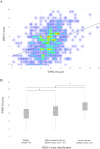Prevalence and associated factors for self-reported symptoms of dry eye among Thai school children during the COVID-19 outbreak
- PMID: 37093868
- PMCID: PMC10124893
- DOI: 10.1371/journal.pone.0284928
Prevalence and associated factors for self-reported symptoms of dry eye among Thai school children during the COVID-19 outbreak
Erratum in
-
Correction: Prevalence and associated factors for self-reported symptoms of dry eye among Thai school children during the COVID-19 outbreak.PLoS One. 2024 Nov 20;19(11):e0314413. doi: 10.1371/journal.pone.0314413. eCollection 2024. PLoS One. 2024. PMID: 39565792 Free PMC article.
Abstract
Purpose: COVID-19 pandemic caused an increase in digital screen time, which seemed to increase the prevalence of dry eye symptoms among the population with abnormally high digital screen usage hours. However, there are no reports of dry eye symptoms in school children with high digital usage hours. Therefore, the present study aimed to assess the prevalence of dry eye symptoms and evaluate the associated factors among school children aged 12 to 18 years during the COVID-19 outbreak.
Methods: Multistage cluster sampling was applied, and six sections of online questionnaires were distributed to selected respondents in November 2021. The odds ratio (OR) with confidence intervals (CIs) for the factors was calculated using binary logistic regression. All statistical significance was determined at p < 0.05.
Results: The findings revealed that 62.5% of 603 students showed symptoms of dry eye (DEQ-5 score ≥ 6). Significant associated factors included being female (adjusted OR (aOR) 1.54; 95% CIs 1.05-2.25), higher-grade student (aOR 1.77; 95% CIs 1.23-2.57), digital screen time use (6 to < 12 hours: aOR 2.00; 95% CIs 1.12-3.57, ≥12 hours: aOR 2.54; 95% CIs 1.39-4.76), and perceived stress (aOR 1.12; 95% CIs 1.08-1.16). The Thai-Perceived Stress Scale-10 scores were positively correlated with the scores on the 5-item dry eye questionnaire (Spearman's r = 0.38, p-value < 0.01).
Conclusion: A high prevalence of dry eye symptoms might be common among school children during the COVID-19 outbreak. Significant risk factors include being female, being a higher-grade level student, prolonged use of digital screens, and perceived stress. However, contact lens use, smoking, and the most common digital device usage patterns were not found to be contributing factors.
Copyright: © 2023 Tonkerdmongkol et al. This is an open access article distributed under the terms of the Creative Commons Attribution License, which permits unrestricted use, distribution, and reproduction in any medium, provided the original author and source are credited.
Conflict of interest statement
The authors have declared that no competing interests exist.
Figures


Similar articles
-
Assessment of dry eye symptoms among university students during the COVID-19 pandemic.Clin Exp Optom. 2022 Jul;105(5):507-513. doi: 10.1080/08164622.2021.1945411. Epub 2021 Jul 19. Clin Exp Optom. 2022. PMID: 34279190
-
Effects of digital devices and online learning on computer vision syndrome in students during the COVID-19 era: an online questionnaire study.BMJ Paediatr Open. 2022 Jun;6(1):e001429. doi: 10.1136/bmjpo-2022-001429. BMJ Paediatr Open. 2022. PMID: 36053639 Free PMC article.
-
Dry eye symptoms and digital eyestrain - Emerging epidemics among university students due to online curriculum amid the COVID-19 pandemic. A cross-sectional study.Indian J Ophthalmol. 2023 Apr;71(4):1472-1477. doi: 10.4103/IJO.IJO_2760_22. Indian J Ophthalmol. 2023. PMID: 37026285 Free PMC article.
-
Prevalence of dry eye during the COVID-19 pandemic: A systematic review and meta-analysis.PLoS One. 2023 Dec 13;18(12):e0288523. doi: 10.1371/journal.pone.0288523. eCollection 2023. PLoS One. 2023. PMID: 38091282 Free PMC article.
-
COVID-19 and Dry Eye.Eye Contact Lens. 2021 Jun 1;47(6):317-322. doi: 10.1097/ICL.0000000000000797. Eye Contact Lens. 2021. PMID: 33990103 Review.
Cited by
-
Considerations of COVID-19 in Ophthalmology.Microorganisms. 2023 Aug 31;11(9):2220. doi: 10.3390/microorganisms11092220. Microorganisms. 2023. PMID: 37764064 Free PMC article. Review.
-
Correction: Prevalence and associated factors for self-reported symptoms of dry eye among Thai school children during the COVID-19 outbreak.PLoS One. 2024 Nov 20;19(11):e0314413. doi: 10.1371/journal.pone.0314413. eCollection 2024. PLoS One. 2024. PMID: 39565792 Free PMC article.
-
Dry Eye Syndrome in Children during the COVID-19 Pandemic.Korean J Ophthalmol. 2024 Dec;38(6):441-449. doi: 10.3341/kjo.2024.0076. Epub 2024 Oct 22. Korean J Ophthalmol. 2024. PMID: 39434581 Free PMC article.
-
Prevalence of dry eye disease among children: a systematic review and meta-analysis.BMJ Open Ophthalmol. 2025 Feb 19;10(1):e002014. doi: 10.1136/bmjophth-2024-002014. BMJ Open Ophthalmol. 2025. PMID: 39971589 Free PMC article.
References
-
- World Health Organization. WHO Director-General’s opening remarks at the media briefing on COVID-19 [Internet]. 2020. [cited 1 Aug 2021]. Available from: https://www.who.int/director-general/speeches/detail/who-director-genera....
-
- The United Nations Education, Scientific and Cultural Organization. From disruption to recovery 2020 [Internet]. 2020 [cited 15 Feb 2022]. Available from: https://en.unesco.org/covid19/educationresponse
-
- Khamkaew S. The effects of online learning during the outbreak of Coronavirus Disease 2019 (COVID-19) towards grade 10–12 Thai students’ opinions. Journal of World Englishes and Educational Practices 2021;3(1).
Publication types
MeSH terms
LinkOut - more resources
Full Text Sources
Medical

